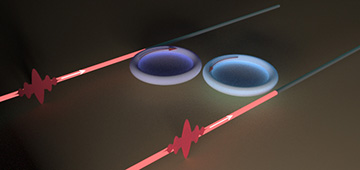
Researchers in the United States have optimized the absorption of a pair of microresonators, each coupled to a waveguide, by tuning their losses. [Image: Washington University in St. Louis/Lan Yang]
Loss, an ever-present feature of natural and manmade systems, is usually regarded as a nuisance to be minimized. But scientists have also shown how it can be exploited to yield new types of optical control and engineering.
In that vein, researchers at Washington University in St. Louis, USA, and Yale University, USA, have shown that by precisely tuning losses in a pair of microresonators, the resonators can absorb almost all incoming laser light across a broader band of frequencies than was previously possible (Science, doi: 10.1126/science.abj1028). This ability, the team claims, could provide benefits in photonics, electronics and beyond.
Whisper it
A microresonator consists of a tiny ring or disk generally made from a dielectric. It operates in whispering-gallery mode—named after the circular gallery in St. Paul’s Cathedral, London, that carries sound waves around its circumference with little attenuation. The phenomenon of resonance similarly allows microresontors of a given diameter to trap light waves with a certain frequency.
These devices experience two main sources of loss. One of these is via absorption in the walls of the resonator itself. The other occurs in the coupling between a resonator and the waveguide that directs laser light in and out of the system.
In the new research, Lan Yang of Washington University in St. Louis and colleagues studied a system of two coupled microresonators, each with its own fiber waveguide. The idea was to tune the system’s absorption by varying the gap between resonators and waveguides.
Lasing in reverse
As lead author Changqing Wang explains, each microresonator on its own can be made to undergo what is known as coherent perfect absorption—basically lasing process in reverse. In coherent perfect absorption, the device absorbs all incoming light while emitting and scattering none. This occurs for a given frequency of light and a certain ratio of coupling to absorption losses.
What the researchers did was to vary the distance and hence coupling between the microresonators. They showed that at just the right distance, the two devices acted as one, becoming “degenerate” and restricting perfect absorption to just a single frequency. Crucially, says Wang, the frequency at this “exceptional point” was not characterized by a conventional narrow line, but instead by a broader band.
In a Washington University press release, Wang noted that this dual resonator system is fundamentally different from other types of open wave systems in which energy is not conserved—behaving neither like “a single absorber, nor simply the sum of two absorbers.”
Tuning the absorption
What’s more, the researchers discovered that by slightly modifying the delay between the laser beams funneled by the two waveguides, they could vary the degree of absorption in the system between 0% and 80%.
According to team leader Yang, the work “brings insight for various applications in photonics, acoustics, electronics and quantum systems.” She says that the broadened absorption spectrum could be exploited to make news kinds of ultrasensitive optical devices for detecting nanoparticles, measuring rotations or imaging biological tissue.
Yang adds that she and her colleagues have obtained their results by varying loss alone. This, she says, will make for “simpler, more accessible, and more stable” devices than would be the case if they also had to vary gain—which can create additional noise and thereby degrade performance.
“Loss is ubiquitous in nature,” she says. “By better understanding it we make it more useful.”

